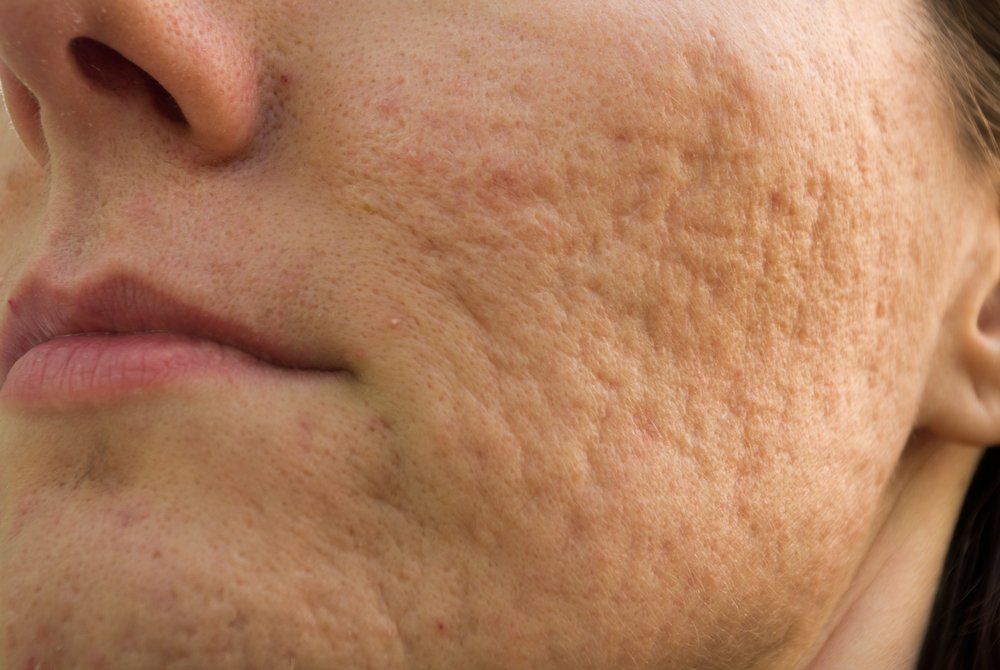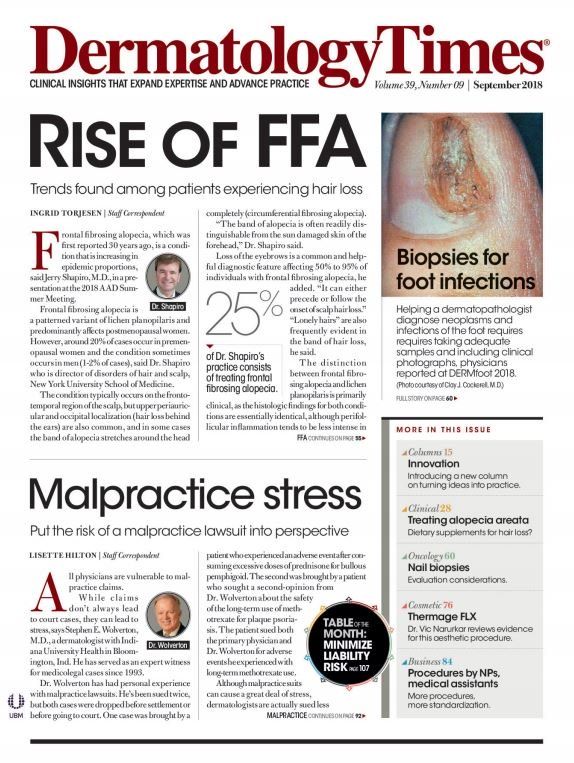- Case-Based Roundtable
- General Dermatology
- Eczema
- Chronic Hand Eczema
- Alopecia
- Aesthetics
- Vitiligo
- COVID-19
- Actinic Keratosis
- Precision Medicine and Biologics
- Rare Disease
- Wound Care
- Rosacea
- Psoriasis
- Psoriatic Arthritis
- Atopic Dermatitis
- Melasma
- NP and PA
- Skin Cancer
- Hidradenitis Suppurativa
- Drug Watch
- Pigmentary Disorders
- Acne
- Pediatric Dermatology
- Practice Management
- Prurigo Nodularis
- Buy-and-Bill
Publication
Article
Dermatology Times
Topical treatment reduces scar formation in acne
Author(s):
Treatment may offer an alternative to topical retinoid treatments for acne scarring.
The topical gel adapalene 0.3%/benzoyl peroxide 2.5% gel (A0.3/BPO2.5) has been found to prevent and reduce atrophic scar formation in acne, in a 24-week study published in the American Journal of Clinical Dermatology.(©BudimirJevtic/Shutterstock.com)

The topical gel adapalene 0.3%/benzoyl peroxide 2.5% gel (A0.3/BPO2.5) has been found to prevent and reduce atrophic scar formation in acne, in a 24-week study published in the American Journal of Clinical Dermatology.
Facial scarring is frequent in patients with acne, especially if acne is not treated early and effectively, and atrophic scars, involving loss of tissue, are the most frequently type. Treatment for scarring often involves invasive procedures, such as laser resurfacing, volumizing fillers, dermabrasion, and excisional techniques such as punch excision, punch elevation and punch replacement, so reducing the occurrence and severity of scars is preferable.
Adapalene 0.3%/benzoyl peroxide 2.5% fixed-dose combination gel (A0.1/BPO2.5 gel) combines a retinoid with benzoyl peroxide, which exhibits potent and rapid bactericidal effect on Cutibacterium (formerly Propionibacterium) acnes. Topical retinoids target multiple aspects of acne pathophysiology, including normalizing infundibular hyperkeratinization and reducing inflammation, and have a unique class action in reducing the formation of acne precursor lesions (microcomedones) and limiting the development of new lesions. However, although there is considerable evidence supporting the efficacy of topical retinoid treatments for primary lesions of acne, few previous studies have looked at their impact on reducing acne scars so researchers set out to look at the impact of A0.1/BPO2.5 gel.
The study included 67 patients aged 16–35 years with Fitzpatrick skin phototype I–IV who had moderate to severe facial acne, and distribution of inflammatory and non-inflammatory lesions. Atrophic acne scarring on their faces was roughly symmetrical.
At the start of the study patients had an average of approximately 40 acne lesions and 12 scars per half face. All patients had an Investigator’s Global Assessment (IGA) score of three or four on both sides of their face, at least 25 inflammatory lesions (papules and pustules) with ten or more on each side of their face (excluding the nose); and ten or more atrophic acne scars greater than 2 mm (for whole face excluding the nose).
The patients, were enrolled at five centers in Canada and one in France, and were randomized to apply A0.3/BPO2.5 on half of their face and the vehicle gel (without the active ingredients) on the other half of their face every evening for 24 weeks. They were asked to apply two pea-sized amounts per half face. None of the patients were using systemic therapy. Fifty four (80.6%) of the 67 patients completed the study between May 2016 and November 2017.
The results showed that by week 24, half faces treated with A0.3/BPO2.5 had 3.8 fewer scars than half faces treated with the vehicle gel â a mean of 9.5 scars versus 13.3 respectively. The scar count had fallen by 15.5% for half faces treated with A0.3/BPO2.5 while it had increased by 14.4% for half faces to which the vehicle gel was applied, meaning there was an approximate 30% difference in scar count between the two treatments.
There was also a 16.5% difference between the proportion of half faces treated with A0.3/BPO2.5 and the proportion treated with vehicle deemed clear/almost clear using Scar Global Assessment (SGA) at 24 weeks; 32.9% of half faces treated with A0.3/BPO2.5 were consider clear/almost clear compared with 16.4% of those treated with vehicle gel (p < 0.01).
Reductions in acne lesions were observed for both gels but were far greater for A0.3/BPO2.5 The reduction in inflammatory lesions with use of A0.3/BPO2.5 was 86.7% compared with 57.9% for vehicle gel, and for non-inflammatory lesions it was 86.7% for A0.3/BPO2.5 versus 57.9% for vehicle gel. Global improvement of acne occurred with both gels, but significantly more subjects were IGA clear/almost clear with A0.3/BPO2.5 than with vehicle gel at 24 weeks - 64.2% compared with 19.4%, a difference of 45%. Improvements in skin roughness and texture were also greater with the A0.3/BPO2.5 gel.
Reduction in inflammatory lesion counts and percentage IGA clear/almost clear skin at week 12 in this study were very similar to reductions observed in a previous 12-week phase III study, the researchers said.
“By continuing up to 24 weeks in our study, the percentage of subjects with clear/almost clear skin continued to increase and doubled between week 12 and week 24 on the A0.3/BPO2.5 side,” said Brigitte Dréno, of the University of Nantes, Nantes in France. “The progressive incremental increase in efficacy and effect on scars observed with A0.3/BPO2.5 over 24 weeks highlights the importance of a longer duration of treatment. In fact, 3 months may be sufficient to observe resolution of the primary acne lesions, but the remodeling processes occur slowly, and 6 months may be required to induce significant stimulation of the dermal fibroblasts and collagen and clinically observe an effect on scars.”
No serious or severe adverse events were reported. Treatment-related adverse events were reported by 20.9% of patients for A0.3/BPO2.5 gel use and 9% for vehicle gel, and the most frequent problem was skin irritation, particularly during the first few weeks. However, by week 24, 44.3% of patients were not bothered at all by side effects from A0.3/BPO2.5 and 77.0% were not bothered by them with vehicle gel. Only two patients dropped out because of adverse events.
The majority of patients (90.1%) said they were satisfied or very satisfied with the A0.3/BPO2.5 treatment compared with 59.0% for vehicle gel.
Most patients included in the study had moderate acne (92.5% IGA 3 at the start), so further studies are needed, especially in patients with severe acne “to confirm these promising results and evaluate the best treatment regimen to further reduce atrophic acne scars”, she said.
References:
Dréno, B., Bissonnette, R., Gagné-Henley, A. et al. Prevention and Reduction of Atrophic Acne Scars with Adapalene 0.3%/Benzoyl Peroxide 2.5% Gel in Subjects with Moderate or Severe Facial Acne: Results of a 6-Month Randomized, Vehicle-Controlled Trial Using Intra-Individual Comparison. Am J Clin Dermatol (2018) 19: 275. https://doi.org/10.1007/s40257-018-0352-y
Stein Gold L, Weiss J, Rueda MJ, et al. Moderate and severe inflammatory acne vulgaris effectively treated with single-agent therapy by a new fixed-dose combination adapalene 0.3%/benzoyl peroxide 2.5% gel: a randomized, double-blind, parallel-group, controlled study. Am J Clin Dermatol. 2016;17(3):293–303.CrossRefPubMedPubMedCentralGoogle Scholar






